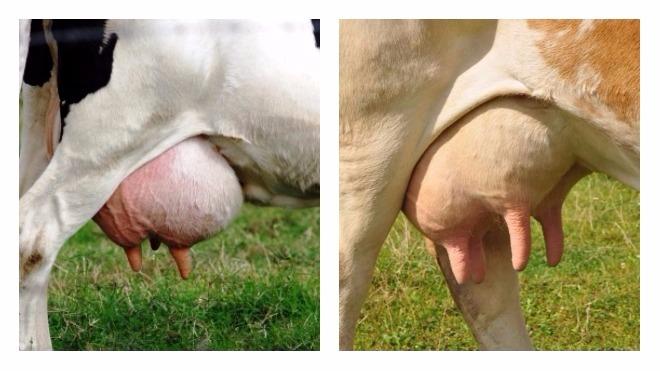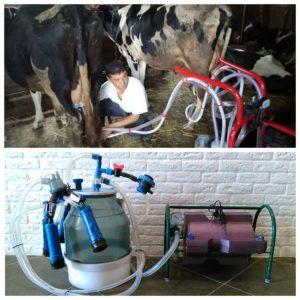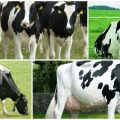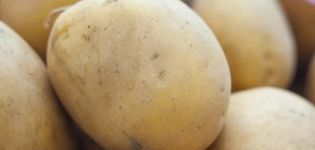Types of cows and how to choose the right animal, top 5 main criteria
A productive cow is considered an invaluable source of milk and meat. At the same time, it will be possible to obtain high parameters of products due to the correct choice of an animal. But here it is important to consider a number of parameters. These include the age, appearance of the animal, the condition of its udder. Some farmers are even guided by folk signs. So how can you choose the right cow?
Types of cows by direction
All breeds are divided into several groups. Taking into account the direction, there are dairy, meat and meat and dairy breeds. If cows are bred for milk, it is worth choosing purebred dairy cows. They are characterized by a light head and the same skeleton, an elongated body, a large udder, long legs. Such animals are distinguished by developed lungs and digestive organs.
If you plan to raise a cow for meat, you should choose a meat breed. Such animals are always large in size, characterized by early maturity, large weight and powerful constitution. The milk of such animals is enough only for feeding the calves.
If you need animals with high milk yield and high-quality meat, you should look for meat and dairy animals. It is quite profitable to breed them. Such individuals are characterized by average parameters of milk yield and an excellent slaughter yield. Moreover, the meat has excellent taste.
Rules for choosing cattle when buying
To buy a productive animal that differs in the required parameters, it is important to choose the right one. In this case, it is worth considering a whole range of features.

Outwardly
To choose a good cow, you should consider the following parameters:
- The head should be elongated. A dry and light head is a good option. It is important that the eyes are large and expressive, the ears are thin and bald on the inside and covered with hairs on the outside. Productive animals are characterized by medium horns, which become thinner near the base.
- Neck - Cows have a long neck with many folds. It is important that the bib is medium in size.
- Skin - it is important that it is firm and elastic. It is important to ensure that it folds easily and does not contain fat.
- Body - the animal is characterized by a large body and strong bones. Moreover, it is distinguished by poorly developed muscles. The round belly makes the cow barrel-shaped. It is desirable that the chest is wide and powerful. It is characterized by wide intercostal bases. This indicates the full development of the lungs and digestive organs. It is important that the tail is long but not thick. In this case, the rear is slightly raised.
It is important to consider that a flat chest often indicates a threat of developing tuberculosis or other pulmonary diseases.
Proportions are also important. A productive dairy cow looks slightly angular. This is due to the full development of the rear.
According to the age
Of course, the cow doesn't have to be old. It is often advised to buy a heifer - females at 5-6 months of pregnancy. They usually cost more than a heifer but less than an adult. Moreover, such a purchase has the following advantages:
- the ability to get a calf after a while;
- the ability to properly milk an animal in order to make a productive individual out of it.
At the same time, the purchase is associated with certain risks:
- the threat of difficult childbirth;
- unpredictable productivity parameters;
- the need to accustom heifers to milking.

First-calf heifers or females after 2 calving are distinguished by low milk productivity. The maximum parameters of milk yield are reached by the sixth calving. Of course, documents help determine the age of the animal. However, in many farms, information on the date of birth of the cow is not available. In such a situation, the approximate age is established by the rings that are on the horns.
In appearance, the rings resemble grooves. They appear due to a change in the nutrition of peripheral tissues during pregnancy. To determine age, you need to count the number of rings on the horns and add 2, since the first calving is observed at 2 years.
Udder
To acquire a productive dairy cow, it is advisable to examine the mammary glands. To get the most milk, you need to choose an animal that has a wide, bowl-shaped udder. It is important that it protrudes well and is close to the body. It is desirable that all 4 beats have an even and symmetrical arrangement.

When palpating the mammary glands, it is important to ensure that they have a soft consistency and elasticity. It is important to ensure that there is no hardening. When examining the nipples, it is recommended to control that they are equal in size - 8-10 centimeters in length and 2-3 centimeters in diameter. Productive cows are characterized by cylindrical teats. In doing so, they must hang vertically. It is important that there are no wounds or growths on their surface.
It is important that the veins are clearly visible in the udder - this indicates the full development of the circulatory system.
It is not recommended to buy females that have saggy triangular udders. It should not have developed lobes or thick and long nipples. Usually these animals bring a minimum of milk. The udder grows and develops up to 4-6 genera. After 7-8 calving, extinction is observed. The maximum productivity of cows occurs after 4 calving. The duration of lactation depends on the conditions of detention. It is also influenced by a balanced diet, quality care, and correct milking technique.
For health
To purchase a quality heifer, you should pay attention to the following signs:
- cheerful appearance;
- healthy teeth;
- firm and light gait;
- well-groomed wool - it is important that it shines;
- lively eyes with sparkle.
Sick animals constantly lie down and move little. They cough frequently. Also in this case, sad eyes, dull hair, drooping head are observed. Cows often have nasal and eye discharge. Loss of appetite is also common.
According to folk signs
There are different signs that help you choose a productive dairy cow. Of course, they only provide some guesses about performance parameters. To specialists, individual signs seem absurd at all.
However, people often consider the following when buying a cow:
- If an animal has 8 teats, this indicates a high milk yield.
- The presence of a deep fossa between the horns indicates high parameters of milk production.
- Productivity is evidenced by the downward forelock.
- If a cow has a lot of sulfur in the ears, this indicates a high fat content of milk.
- If the animal has a yellowish round tail, you should expect increased milk fat.
When choosing a cow, first of all, you should focus on high parameters of milk production. These indicators are influenced by hereditary tendency, age, exterior. If you take into account all of the above parameters, you will be able to get a lot of fat milk.















